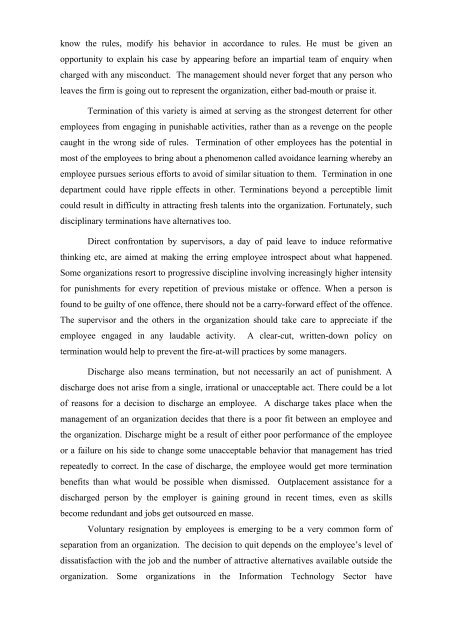UNIT – I Lesson 1 HRM – AN OVERVIEW Lesson Outline Nature of ...
UNIT – I Lesson 1 HRM – AN OVERVIEW Lesson Outline Nature of ...
UNIT – I Lesson 1 HRM – AN OVERVIEW Lesson Outline Nature of ...
Create successful ePaper yourself
Turn your PDF publications into a flip-book with our unique Google optimized e-Paper software.
know the rules, modify his behavior in accordance to rules. He must be given an<br />
opportunity to explain his case by appearing before an impartial team <strong>of</strong> enquiry when<br />
charged with any misconduct. The management should never forget that any person who<br />
leaves the firm is going out to represent the organization, either bad-mouth or praise it.<br />
Termination <strong>of</strong> this variety is aimed at serving as the strongest deterrent for other<br />
employees from engaging in punishable activities, rather than as a revenge on the people<br />
caught in the wrong side <strong>of</strong> rules. Termination <strong>of</strong> other employees has the potential in<br />
most <strong>of</strong> the employees to bring about a phenomenon called avoidance learning whereby an<br />
employee pursues serious efforts to avoid <strong>of</strong> similar situation to them. Termination in one<br />
department could have ripple effects in other. Terminations beyond a perceptible limit<br />
could result in difficulty in attracting fresh talents into the organization. Fortunately, such<br />
disciplinary terminations have alternatives too.<br />
Direct confrontation by supervisors, a day <strong>of</strong> paid leave to induce reformative<br />
thinking etc, are aimed at making the erring employee introspect about what happened.<br />
Some organizations resort to progressive discipline involving increasingly higher intensity<br />
for punishments for every repetition <strong>of</strong> previous mistake or <strong>of</strong>fence. When a person is<br />
found to be guilty <strong>of</strong> one <strong>of</strong>fence, there should not be a carry-forward effect <strong>of</strong> the <strong>of</strong>fence.<br />
The supervisor and the others in the organization should take care to appreciate if the<br />
employee engaged in any laudable activity. A clear-cut, written-down policy on<br />
termination would help to prevent the fire-at-will practices by some managers.<br />
Discharge also means termination, but not necessarily an act <strong>of</strong> punishment. A<br />
discharge does not arise from a single, irrational or unacceptable act. There could be a lot<br />
<strong>of</strong> reasons for a decision to discharge an employee. A discharge takes place when the<br />
management <strong>of</strong> an organization decides that there is a poor fit between an employee and<br />
the organization. Discharge might be a result <strong>of</strong> either poor performance <strong>of</strong> the employee<br />
or a failure on his side to change some unacceptable behavior that management has tried<br />
repeatedly to correct. In the case <strong>of</strong> discharge, the employee would get more termination<br />
benefits than what would be possible when dismissed. Outplacement assistance for a<br />
discharged person by the employer is gaining ground in recent times, even as skills<br />
become redundant and jobs get outsourced en masse.<br />
Voluntary resignation by employees is emerging to be a very common form <strong>of</strong><br />
separation from an organization. The decision to quit depends on the employee’s level <strong>of</strong><br />
dissatisfaction with the job and the number <strong>of</strong> attractive alternatives available outside the<br />
organization. Some organizations in the Information Technology Sector have
















